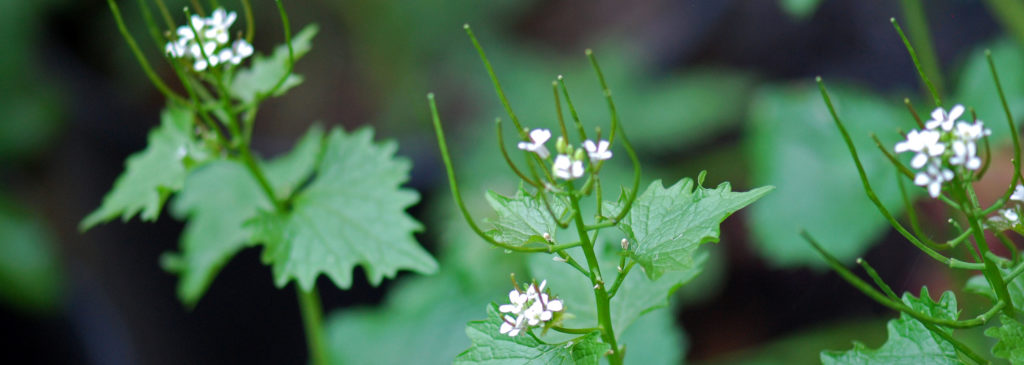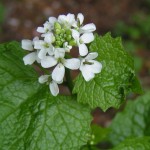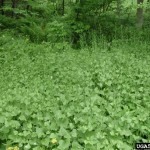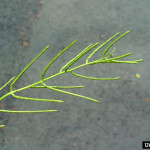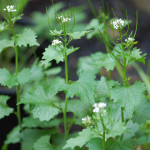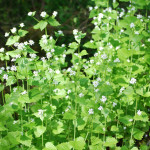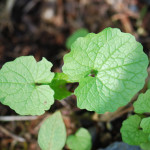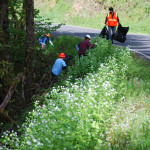Common name:
Garlic mustard, Jack-by-the-hedge
Scientific Name:
Alliaria petiolata (syns. Alliaria alliaria)
Noxious Weed Listing:
- WeedWise: Containment
- State of Oregon: Class B
- State of Washington: Class A
- 4-County CWMA: Class A
- Columbia Gorge CWMA: Class A
Description:
General:
Garlic mustard is a biennial plant in the Brassicacaea (Mustard) family. Garlic mustard is an aggressive woodland invader throughout much of the continental United States. It affects both disturbed and pristine woodlands and has become one of the worst invaders of forests in the American Northeast and Midwest regions. The plant can form dense stands up to 4 ft in height and can aggressively out-compete other native plants. The most identifying set of factors for this plant are its white, cross-shaped (cruciform) flowers and presence of a garlic odor on crushed leaves.
Leaves:
The leaves of this plant are stalked with kidney-shaped to triangular leaves and a coarsely-toothed margin. The leaves vary in length from less than 1 inch to more than 6 inches. The basal rosette features primarily kidney-shaped leaves while the mature flowering stalks have triangular leaves. When crushed, the leaves typically have a pungent garlic-like odor.
Flowers
Garlic mustard flowers have four small, white petals that grow in the shape of a cross. The flowers emerge on mature plants from May to June in our region. The flowers have 4 sepals that are generally half as long as the petals.
Fruits
Garlic mustard produces elongated seed pods that are slender, slightly curving, and up to 3 inches long. Adult plants can produce up to 8000 seeds which can remain viable in the soil for more than 10 years. The seeds are brown to black, grooved, and oblong when mature.
Roots
This plant has roots that typically feature an S-shaped hook or bend just below the soil line on its single taproot.
Reproduction:
This species reproduces exclusively by seed. Seeds most often fall near the parent plant, but, importantly, are also transported by moving water, wildlife, and contaminated equipment such as hiking boots, mowers, and vehicles. Stands of garlic mustard can produce more than 62,000 seeds per square meter. The seeds germinate in the late winter and spring at typically very high densities and form rosettes in their first year of growth. The rosettes overwinter and begin to bolt and flower the following spring and summer. The seeds can survive in the soil for up to 10 years and still germinate.
Habitat:
Garlic mustard grows best in filtered to partial light. However, in our region garlic mustard can grow in an exceptionally wide variety of habitats including both open and shaded ones as well as upland and stream-side locations. It grows on sand, loam, and clay soils. Where this plant is most abundant in Clackamas County, it is predominantly found near rivers, roadsides, and on non-turf portions of parks and residential properties.
Impacts:
- Garlic mustard can invade healthy forests and severely reduce biodiversity through highly successful competition for light.
- It is thought to produce a toxin that kills soil fungi that other native plants are dependent on, including native tree seedlings.
- Degrades wildlife habit and reduces the diversity of animals in infested areas.
Introduction:
Garlic mustard is native to Europe, North Africa, and parts of Asia. It was originally introduced to North America as a garden and medicinal herb. The first documentation of garlic mustard growing in North America is from 1868 on Long Island, NY. In Oregon, the earliest herbarium record is from 1959 on the Reed College campus. While it has been around for numerous decades, it has only been in the last two decades that the plant has begun to rapidly expand its geographic range in our area. This lag period is a common phenomenon that many invasive plants exhibit when introduced to a new region. Significant efforts throughout the Portland region are underway to contain, suppress, and, in many areas, attempt to eradicate garlic mustard populations.
Distribution:
Clackamas County:
This plant can be found in several communities and river systems in Clackamas County, but it is not widespread. This species is actively surveyed for, but the mapped distributions do not represent the full extent of the population in Clackamas County. Please report any sightings of this weed, even if nearby populations have already been mapped.
State of Oregon:
United States:
Management:
Strategy:
The management of invasive weeds is best served through a process known as Integrated Pest Management (IPM). IPM is a weed management methodology that utilizes:
- Management thresholds to determine when and if to initiate control,
- The ecology and life history characteristics of the targeted invasive weed,
- Site-specific conditions and land use considerations to inform management practices,
- The effectiveness and efficiency of various control methods.
An IPM based strategy ensures the maximum effectiveness of treatment measures. IPM strategies typically use more than one management method to target one or more susceptible life stages. It is adaptive to site conditions in the field and to the response of a plant to management. The utilization of multiple management tools also inherently reduces the use of herbicides in a management plan. The IPM process ultimately provides a framework for the establishment of Best Management Practices (BMP) which outlines the best approach for controlling a weed particular infestation.
Manual:
Garlic mustard can be effectively controlled through hand pulling. Care must be taken to remove the taproot completely. Root fragments left in the ground can resprout. The highest priority for all methods of control is to target the second-year plants to prevent seed production. Hand pulling is often, however, not practical on well-established, extensive populations or in areas with compacted soils. Removed plant material should be bagged and placed in the trash.
Mechanical:
Generally, mowing is not recommended. However, when done properly frequent mowing can reduce or eliminate seed production. Plants should be cut as low as practical and should be cut repeatedly throughout the spring and early summer. Be sure to monitor your work to ensure that you are effectively suppressing flowering and seed production. Be sure to prevent the spread of seeds by cleaning equipment well and managing any adjacent, unmowed affected areas.
Cultural:
Garlic mustard is not toxic and is edible. Grazing animals tend to avoid garlic mustard due to its pungent garlic-like odor but will graze it when more desirable vegetation is depleted. Garlic mustard is best grazed before flowering to reduce seed production, but grazing alone will not eliminate garlic mustard. For dairy producers, grazing is not recommended as garlic mustard is known to impart an unpleasant odor to the taste of milk.
Chemical:
Before you Start:
- Before purchasing any herbicide product it is important to read the label. The label is the Law. Carefully review all parts of the label even if you have used the product before. Select a product that is most appropriate for your site. If you have questions, ask your vendor before purchasing a product.
- When selecting herbicides always use a product appropriately labeled for your site. Follow label recommendations and restrictions at all times. If any information provided here contradicts the label, the label takes precedence. Always follow the label!
- Protect yourself. Always wear the recommended protective clothing identified on your label and shower after use.
- When applying herbicides use spot spray techniques whenever possible to avoid harming non-target plants.
- Do not apply during windy or breezy conditions that may result in drift to non-target plants
- Avoid spraying near water. Hand-pull in these areas, to protect aquatic and riparian plants and wildlife.
- Avoid exposure to pets, pollinators, and wildlife. Remove animals from treatment areas to avoid exposure to herbicides. Follow the reentry instructions on your herbicide label and keep pets out of the area until the herbicides have dried. Avoid spraying when insects and animals are active. Avoid spraying blooming plants to minimize any effects to bees and pollinators.
- Be sure to store any chemicals, out of the reach of children and pets to keep your family safe.
Herbicides:
The mention of any brand name product is not, and should not be construed as an endorsement for that product. They are included here only for educational purposes. Suggested rates are generalized by active ingredient. Specific rates will vary between products. Be sure to review the label before application and use the recommended label rate at all times.
Active Ingredients
Product Names: Accord, Aquamaster, Rodeo, Roundup, and various others
Rate:
Broadcast: 2 – 4 pt product per acre (1.1 to 2.25 lb ae/acre)
Spot treat: use 1% to 3% v/v solution
Time: Postemergence to rosettes in late Fall or early Spring when plants are in the rosette stage.
Comments: Re-treatment may be required to achieve effective control. Glyphosate is not selective and will harm grasses. Use care when working around desirable plants to avoid damage. Mature plants can be controlled with glyphosate with some caveats. Mature plants often die very slowly when applied with Glyphosate and may not halt seed production.
Product Names: Garlon 4 (triclopyr ester), Garlon 3A, Element 3A (triclopyr amine)
Rate:
Broadcast: Triclopyr ester- 8 oz. product per acre
Spot treat: Triclopyr ester use 1.25% to 2.5% v/v solution, Triclopyr amine use 2% v/v solution
Time: Triclopyr provides good control when applied to rosettes through until the mature, flowering stage.
Comments: Triclopyr is selective and will harm desirable broadleaf plants, trees, and shrubs. Use care when working around desirable plants to avoid damage. Leaves should be sprayed until wet but not dripping to achieve good control. Triclopyr ester formulations may volatilize under warm temperatures.
Product Names: various
Rate:
Broadcast: 1 pint product per acre
Spot treat: 1% v/v solution
Time: 2,4-D provides some control when applied to rapidly growing plants before flowering stage.
Comments: 2,4-D can be applied alone or mixed with dicamba. Some reports have shown limited success when treating with 2,4-D.
Product Names: Plateau
Rate: 4 to 6 oz of product per acre
Time: Apply post emergence in fall or early spring.
Comments: Use with a methylated seed oil to improve uptake
Product Names: Escort
Rate: 0.5 to 1 oz of product per acre
Time: Apply post emergence in fall or early spring.
Comments: Use a non-ionic surfactant to improve uptake
Product Names: Oust
Rate: 0.5 oz of product per acre
Time: Apply post emergence in fall or early spring.
Comments: Use a non-ionic surfactant to improve uptake
Product Names: Outrider
Rate: 2 oz of product per acre
Time: Apply post emergence in fall or early spring.
Comments: Use a non-ionic surfactant to improve uptake
Biological:
There are no approved biological control agents ready for release in the United States. Currently four weevils under consideration as potential biological control agents. These include two stem mining insects (Ceutorhynchus alliariae & Ceutorhynchus robertii), one root feeder (Ceutorhynchus scrobicollis), and one weevil (Ceutorhynchus constrictus) that develops in the garlic mustard seeds.
Disposal:
Please dispose of mature seeding producing garlic mustard plants as trash. Plants still in the rosette state can be disposed of as yard waste for commercial composting. It is generally not recommended to compost garlic mustard on site, even for immature plants. Soil residues from pulled plants are commonly contaminated by garlic mustard seed, and home compost systems inconsistently reach temperatures sufficient to destroy seeds.
Follow-Up:
Any control plan for garlic mustard will typically require at least five years of control and/or monitoring. Well-established populations will often not show significant reductions in population size until several years of treatments have been performed. Monitor presumed eradicated patches for at least a few years to ensure that no additional seedlings emerge.
Best Management Practices:
Small Infestations:
- Consider the land use practices on site. Identify any site-specific considerations that should be taken into account before initiating control.
- Be sure you can properly identify garlic mustard. If you are unsure about your weed bring a sample to the Conservation District, and we can help to identify your particular weed.
- If you are working on public property be sure to coordinate with the land manager.
- Identify any native or desirable plants nearby, and take precautions to minimize any negative impact on them.
- Hand pull all adult plants after bolting has been initiated in the spring, typically sometime in April. Bag plants and place in the trash.
- Do not hand pull once seed production has begun to reduce the risk of spreading seeds.
- Repeated visits and a very thorough survey of infested areas over the course of the spring is required to get good control using manual methods.
- Applications of glyphosate or triclopyr at recommended label rates can be very effective on smaller sites, particularly when dealing with dry and compacted soils.
Large Infestations:
- Consider the land use practices on site. Identify any site-specific considerations that should be taken into account before initiating control.
- Be sure you can properly identify garlic mustard. If you are unsure about your weed bring a sample to the Conservation District, and we can help to identify your particular weed.
- Identify any native or desirable plants nearby, and take precautions to minimize any negative impact on them.
- Apply glyphosate or triclopyr at recommended label rates to bolting plants or flowering plants and any rosettes or seedlings present. Glyphosate may not effectively halt seed production when applied to late flowering individuals.
- It is common that seedlings and even mature plants are missed, even with very thoroughly control efforts. Plan to revisit your application site approximately 2-3 weeks after application to perform follow-up control. If the patch is still flowering, reapply using triclopyr. If seed production has begun, but viable seeds are not present, switch to hand pulling to remove remaining plants. If viable seeds are present, leave the site until next year and do not hand pull to avoid spreading seed.
Fun Facts:
- More than 8,000 results are returned from a scholar.google.com search for Alliaria petiolata.
- Garlic mustard affects 38 U.S. states
- Garlic mustard is one of the most nutritious leafy greens ever analyzed. It has more fiber, beta-carotene, vitamin C, vitamin E, and zinc than spinach, broccoli leaves, collards, turnip greens, and kale.
Gallery:
- Detail of flowers
- infestation
- Seed pods
- Garlic mustard stem and flowers
- Garlic mustard flowers
- Garlic mustard rosette
- Garlic mustard flowers
- Garlic mustard seedling
- Garlic mustard control
Additional Information:
- Oregon Department of Agriculture: Garlic mustard profile
- Oregon State University Extension: Forestry garlic mustard management
- City of Portland: Garlic Mustard
- Bugwood Wiki: Alliaria petiolata
- USDA Plants: Alliaria petiolata
- King County Washington: BMP garlic mustard
- Center for Invasive Species and Ecosystem Health
- The Nature Conservancy Element Stewardship Abstract
References:
- Bugwood Wiki. Alliaria petiolata. https://wiki.bugwood.org/Alliaria_petiolata. (accessed January 7th, 2015)
- Christy, J. A., A. Kimpo, V. Marttala, P. K. Gaddis, & N. L. Christy. 2009. Urbanizing Flora of Portland Oregon 1806-2008. Native Plant Society of Oregon Occasional Paper 3 pg. 218.
- DiTomaso, J.M., G.B. Kyser, S.R. Oneto, R. G. Wilson, S. B. Orloff, L. W. Anderson, S. D. Wright, J.A. Roncoroni, T.L. Miller, T.S. Prather. 2013. Weed Control in Natural Areas in the Western United States. Davis, CA: UC Weed Research and Information Center. pp 341-343.
- Kallas, John. “Garlic Mustard.” Edible Wild Plants. Layton: Gibbs Smith, 2010. 231-48.
- Kaufman, S.R. and W. Kaufman. 2007. Invasive Plants: Guide to Identification and Impacts and Control of Commons North American Species. Stackpole Books. Mechanicsburg, PA. pp.277-280.
- King County Noxious Weed Control Program. 2010. King County Best Management Practices for Controlling Garlic Mustard. https://your.kingcounty.gov/dnrp/library/water-and-land/weeds/BMPs/Garlic-Mustard-Control.pdf (accessed January 7th, 2015).
- The Nature Conservancy. Element Stewardship Abstract for Alliaria petiolata (Allaria officianalis) Garlic Mustard. https://www.invasive.org/weedcd/pdfs/tncweeds/allipet.pdf. (accessed January 7th, 2015)
- Oregon Flora Project. 2013. Oregon Plant Atlas: Alliaria petiolata. https://www.oregonflora.org/atlas.php. (accessed January 7th, 2015)
- Peachey, E., editor. 2015. Pacific Northwest Weed Management Handbook [online]. Corvallis, OR: Oregon State University. https://pnwhandbooks.org/weed (accessed Feb 26, 2016

